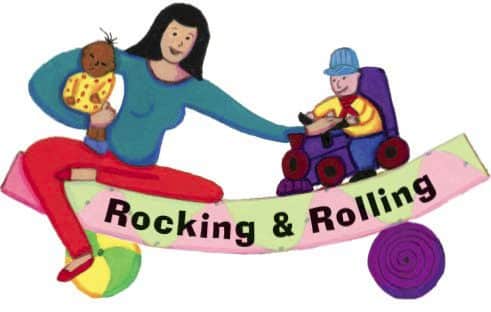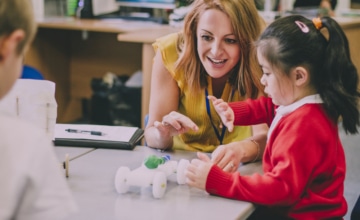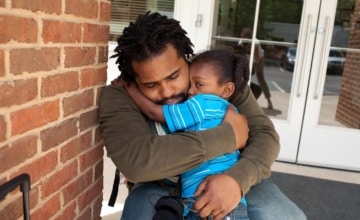Watch how the babies in your care play. What does their play tell you about their development? How do they explore objects? What interests them?
by Linda Gillespie
It is Ella’s first birthday, and her mother is excited. She places a present wrapped with bright paper in front of Ella and tears just a small portion of the paper. Ella takes over, pulling on the paper and scrunching it in her hands. Some tape gets stuck on her finger, and she pulls at it; then it gets stuck on another finger, and she pulls at that. With help, Ella eventually tears all the paper off the box.
Ella’s mother opens the box and takes out the musical elephant inside. She shows Ella how, when she squeezes its foot, the elephant sings the ABC song! Ella looks at the elephant, then at the box and paper. She grabs the paper and crumples it, stuffs it into the box, turns the box upside down, and lets the paper fall out. Ella is delighted, and she does it again and again. In the meantime, Mom is squeezing the elephant’s feet, trying to interest Ella in the real toy!
Wow, what happened here? Why does Ella prefer the wrapping paper and the box to the fancy toy inside? The answer lies in Ella’s development. The toy in the box is one dimensional, and while really cute and interesting to adults, it does not offer the end-less opportunities that the box and the paper do for exploring with all the senses. Infants at one year of age are in the stage of development Piaget called sensorimotor play. The sensorimotor stage of play is characterized by babies actively exploring objects in their environment—first with their eyes, then with their hands and mouths. Ella spent her first year of life practicing this exploratory play.
In the first two months, Ella mostly looked at toys, because her body was not developed enough for her to reach for and hold them. Then, from 4 to 6 months of age, she started to hold on to toys and bring them to her mouth, which she did at every opportunity. In fact, one of the universal characteristics of 4- to 6-month-olds is their ability to look, grasp, and bring objects to their mouths.
From 6 to 8 months, Ella’s play became more sophisticated. Her physical abilities progressed enough that she could explore toys in more meaningful ways. She learned to transfer objects from hand to hand, turn them over, give them to others, and finger, poke, and scratch at them. As Ella grew, she developed the ability to drop one object for another; and because she preferred novelty, she would often drop what she had for what was being offered. At the same time, she began to develop object permanence, knowing that an object exists even when not in sight. As a result of this milestone, she was able to pull the blanket off a favorite toy that was hidden but she wanted to find. So now, at 12 months, Ella likes the wrapping paper and box best!
During the next six months, Ella will begin to experiment with objects. She will scrunch the paper, it will make a noise, and she will change its shape when she pulls it apart. The box is a vessel she can fill, dump, and turn over and bang on. The paper and the box together provide her with endless opportunities to experiment and explore.
At 18 to 24 months, Ella will move into symbolic play, where a block will become a phone or a car. Her play will have more purpose and will take place alongside, and sometimes even with, others. Ella will begin to be able to solve problems through play, like put-ting a cube into a hole or nesting cups. And then the box will become a house or a hat or anything she wants it to be. The opportunities are as endless as her imagination!
THINK ABOUT IT
Watch how the babies in your care play. What does their play tell you about their development? How do they explore objects? What interests them? What is their environment like? Are there safe places on the floor where nonmobile and newly mobile infants can explore? Is there a variety of materials, not just plastic toys?
TRY IT
Offer one new object a week for infants younger than 12 months to explore. Here are some suggestions:
- Make a basket of objects, specifically those that appeal to touch, smell, and sound. Include materials with different textures—a cloth bag with spices in it, wooden items, a bell.
- Provide containers and a variety of materials for dumping and filling.
- Offer bowls of various unbreakable materials like plastic and stainless steel.
- Give infants containers that open and close, like plastic jars of different sizes.
Just be sure that anything you give a baby is large enough not to be swallowed and safe to put into their mouths. And don’t forget the boxes!
Copyright © 2009 by the National Association for the Education of Young Children. See Permissions and Reprints at www.journal.naeyc.org/about/permissions.asp.




